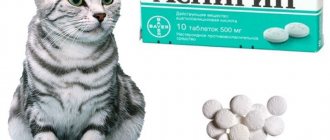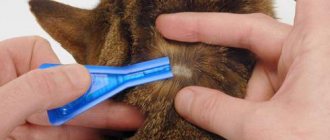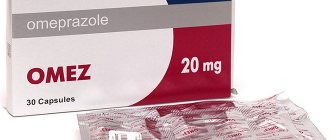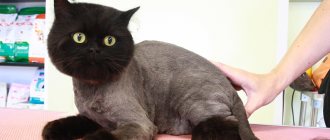Even at the stage of planning to get a cat, think about its safety. It is important to collect essential supplies in case your pet suddenly becomes ill.
On a note!
A first aid kit for a cat contains first aid supplies. It is needed when going to the doctor immediately is not possible. If the owner can immediately contact a veterinarian, he should immediately seek help.
A first aid kit should be in every person's home. The health and even life of the pet can depend on it and on the speed of the owner’s reaction.
Now we will tell you what you should pay attention to when creating a first aid kit for cats.
Signs of pain
Usually cats tolerate pain patiently, but in some cases it is a signal for an urgent visit to the veterinarian.
Signs that your cat is in pain:
- unusual behavior: excessive activity or lethargy;
- unjustified aggressive reactions;
- lack of appetite;
- desire for solitude;
- uncharacteristic apathy and drowsiness;
- refusal of the litter tray;
- drooling and vomiting;
- cardiopalmus;
- heavy or difficult breathing, shortness of breath.
Other effective medicines
A fairly affordable and effective drug for many types of pain is Ketonal
.
Available in tablet and injection form. It is not recommended to use tablets for cats (especially to relieve severe pain). Many owners confuse Ketonal with Ketorol
, but the latter, although it is a powerful painkiller that is used even for cancer, is generally prohibited from being given to cats.
The risk of developing gastrointestinal bleeding
is too No-Shpa is widely known
, but for severe pain this remedy will not help, since it is rather an antispasmodic drug.
In addition, experienced veterinarians advise using Papaverine
, since the cat’s body responds to it much more consistently and without sudden surprises.
When is pain medication needed?
Pain syndrome can be acute and chronic. In case of severe injury or cancer, delay in providing assistance to your pet can lead to painful shock and even death.
Injuries most often occur during fights with dogs and other cats, when the animal is hit by a car, when falling out of a window or simply from a height.
Typically, pain in cats is accompanied by:
- Oncological diseases.
- Injuries - superficial extensive wounds and cuts, fractures of the paws and spine, bruises and torn ligaments.
- Postoperative period after surgery.
- Recovery after castration or sterilization.
- Chronic diseases in the acute stage - pancreatitis, cystitis, urolithiasis, others.
- Kidney or stomach colic.
- Disruption of the nervous system.
- Tooth and jaw pain (usually when enamel is destroyed).
The most popular drugs: dosages
What painkiller can you give your cat? Below are the most effective drugs from the category of painkillers that can be given to your feline pets.
Aspirin
Only a doctor can prescribe aspirin for pain relief for a kitten, since an overdose of acetylsalicylic acid, which occurs when a dose of 22 mgkg is introduced into the body, occurs:
- irritation of the gastrointestinal mucosa;
- stomach ulcer;
- internal bleeding.
Bone marrow function is suppressed. Kidney and liver failure develops. In particularly difficult situations, intoxication of the body develops - the pet dies or falls into a coma.
Aspirin should not be given to animals
Tramadol
Painkillers for cats, marketed under the name Tramadol, are most often prescribed when a four-legged friend is diagnosed with a severe bruise, fracture, or oncology. While taking the drug, side effects may develop such as:
- attacks of nausea;
- gagging;
- drowsiness;
- diarrhea.
The effect of the drug lasts 4-6 hours. Tramadol inhibits the respiratory and cough centers. The medication copes even with severe pain that accompanies neurological diseases, fractures and malignant neoplasms in the body.
The recommended dosage for cats is 3 mg/kg. You can use the medicine once every 8–12 hours.
Baralgin
An anesthetic for cats helps block the synthesis of prostaglandins.
The drug effectively helps fight mild pain.
When diagnosing cancer in a cat, it is better to use other analgesics. In case of severe pain, Baralgin will be ineffective. The recommended dosage of Baralgin for cats is 0.05 mg/kg. To numb your pet, it is better to use a solution.
Omnopon
The analgesic is made on the basis of strong narcotic substances, which include:
It is advisable to use Omnopon in cases of diagnosing malignant neoplasms, previous surgery, or complex trauma. When taking a potent drug, respiratory depression may occur. The activity of the active elements of the product is observed for 4-5 hours. The dosage is selected individually by the doctor.
Codeine
Codeine is a derivative of methylmorphine. Compared to narcotic drugs, the drug is ineffective for severe pain syndrome. The activity of the active elements of the drug is observed for 4 hours after the injection. Side effects that may occur due to the use of codeine include:
- gagging;
- lack of appetite;
- lethargy and malaise.
Painkillers for humans are not suitable for cats.
The dosage of the drug is selected individually by a veterinarian depending on the health status of the furry patient and his age category.
Quadrisol for cats
With the help of Quadrisol, you can effectively relieve pain due to cystitis, relieve swelling and stop inflammation after tumor removal.
The gel is administered orally every day after the cat has eaten. Recommended dosage is 0.4-0.6 ml.
Side effects are not observed while taking Quadrisol.
Ketonal
Veterinarians recommend using Ketonal for cats when diagnosing malignant neoplasms in cats, serious injuries and after surgery.
Older cats can be given no more than 1 tablet every 24-48 hours. Animal metabolism slows down in old age, so more frequent use of Ketonal may worsen the condition of your furry friend. The recommended dosage is 1 mg/kg of pet's weight.
What painkiller can be given to a cat, whether Ketonal is suitable for him, a veterinarian must decide. Self-prescribed medications can harm the health of the mustachioed purr.
Loxicom
Loxicom is a pain reliever for cats that can be used at home. The medication helps block the synthesis of certain enzymes, relieve the inflammatory process and pain.
Special pain reliever for cats
You can also get rid of:
For cats whose weight does not exceed 800-1000 g, experts prescribe 0.1-0.2 ml of medication. Animals whose weight reaches 1-3 kg can be prescribed medication in a dosage of 0.2-0.6 ml. For heavier pets, a dose of 0.3-0.5 ml is recommended.
The duration of therapy should not exceed 9-10 days.
Ketorol
An anti-inflammatory drug for cats can be purchased at any pharmacy chain in the form of tablets and injection solution. Tablets are used for mild pain. In other cases, it is better to give preference to injection. The active components of painkillers for cats can relieve pain.
It is worth considering that the medication belongs to the group of morphines. The recommended dose of Ketorol for a cat is 1 mg per 1 kg of body weight per day. If you plan to use an injection, then it is enough to give your furry friend 1 injection into the paw before bedtime.
Ketorol for a kitten
Spasmalgon
Spasmalgon is often used by people who suffer from headaches and abdominal cramps.
There are times when the severe pain of a cat that has fallen from a height or undergone a complex operation forces doctors to use potent human medication. As a rule, 0.1-0.2 ml of the product is sufficient for a cat.
Types of veterinary drugs for pain
Cats differ from humans and most other domestic animals in their response to pain medications. The list of approved products that do not have a high toxic effect on your pet is very narrow.
Types of analgesics used in veterinary medicine and allowed for cats:
- Narcotic. Prescribed only under the supervision of a veterinarian in exceptional cases - in case of severe injuries and oncological pathologies. These are Omnopon, Fentanyl, Tramadol, Codeine.
- Non-steroidal anti-inflammatory drugs (NSAIDs). Unlike the first group, they are not addictive and not only relieve pain, but also have a therapeutic effect. In acute attacks they are ineffective. These are Ketonal, Ketofen, Quadrisol, Rimadyl, Meloxicam, Vetalgin.
- Other. Some medications intended for treating humans are also suitable for cats. These are Papaverine in the form of injections, Baralgin, some others as prescribed by a doctor.
Types of pain medications
In order to help your furry pet cope with painful sensations, you should give him a painkiller.
Medicines are used to relieve pain
Veterinarians prescribe in these cases:
- Drugs, the frequency of use of which is controlled by a specialist. It is advisable to use such drugs when diagnosing malignant tumors and severe injuries. The most effective narcotic medications include Omnopon, Codeine, Fentanyl and Tramadol.
- Non-steroidal anti-inflammatory drugs (NSAIDs for cats) are not addictive and help cope with various diseases. In case of an acute attack, this group of medications is not prescribed. The best drugs in this category are Ketofen and Ketonal, Quadrisol and Vetalgin.
- Other medications that are used in human therapy. In some cases, medications such as Baralgin, Pentalgin and Papaverine can be used for pain relief.
Table of painkillers approved for cats with approximate dosages
It is recommended to give any painkillers to your pet only as prescribed by a veterinarian and in dosages calculated based on the age, weight, and physiological characteristics of the animal.
Sometimes taking immediate action to relieve a cat's pain is urgent. Approximate dosages are calculated in the table for an average-sized adult animal.
| Drug name | Dosage | Mode of application | Description and price |
| Ketonal | 1 mg per 1 kg of weight, twice a day | Injections | NSAIDs. 10 ampoules of 2 ml - about 250 rubles. |
| Ketofen | 2 mg per 1 kg of weight | In the form of injections or tablets | Wide spectrum of action, not recommended for gastrointestinal diseases. 10 tablets of 5 mg - 500 rub. 20 ml bottle for injections - 1150-1200 rubles. |
| Quadrisol | 1 ml per 10 kg weight | Oral (gel) | A veterinary drug from the NSAID group. Syringe tube 15 ml - no information on cost. |
| Rimadyl 5% | 2 mg per 1 kg of weight, once | Injections | Anti-inflammatory veterinary pain reliever. 20 ml bottle for injections - 2100-2150 rubles. |
| Vetalgin | 1 tablet once or twice a day | Oral (tablets) | A veterinary drug for general use. 10 tablets - 140-170 rubles. |
| Analgivet | 0.05-0.1 ml per 1 kg of weight | Injections | A veterinary drug from the NSAID group. 10 ml - 300 rub. 100 ml - 1200 rub. |
| Dexafort | 0.1-0.2 ml | Injections | Veterinary drug for injuries with swelling. Contraindicated for heart disease. 50 ml bottle for injections - 1000-1100 rubles. |
| Ketoprofen | 2 mg per 1 kg of weight | Injections | A veterinary drug from the NSAID group. 10 ampoules of 2 ml - about 100 rubles. |
Home care
When you bring your cat home, she will probably still be under the influence of anesthesia. In the process of moving away from it, a lethargic animal will experience impaired coordination of movements, inhibited reflexes and poor orientation in space.
While the pet is recovering from anesthesia
Arriving home, you must immediately put the cat on a comfortable bedding, making sure to cover it with a blanket. You can use a heating pad, but do not place it near the seam.
The room in which the animal will be must be warm, windows and vents must be closed. Do not place the litter near heating appliances or in a draft.
Every 30 minutes, a pet lying motionless should be turned over to the other side. In addition, to avoid chapping of the cornea, periodically close your cat's eyelids. You can also use moisturizing eye drops.
The cat recovers from anesthesia from 2 to 12 hours after sterilization, less often - up to a day. At this time, the animal requires close attention, since its movements are still very clumsy. An unsuccessful jump or fall, even from a low sofa, can cause injury to your pet.
It is necessary to place bowls and a tray not far from the cat so that she, who is still poorly oriented in space, can find them more easily.
Blanket for hyperactivity
After recovery from anesthesia, some cats experience a period of agitation and restlessness. At this time, they can react sharply to noises and rush around the room, knocking over everything in their path. You should not try to chase the cat to calm it down, as this will only increase its anxiety.
If the seam bothers your pet, he will try to scratch or lick the seam. This risks introducing bacteria into the wound, which can cause various infections. Therefore, it is very important to purchase a blanket - a simple means of protection that will prevent the animal from licking the wound. It’s great if there are two blankets: one is worn by the cat, and the second can be washed and dried at this time.
The blanket must be adjusted correctly. A tight blanket will rub the skin and prevent air from getting to the wound, which can lead to the suture rotting. Pay special attention to the groin and armpit areas. Too loose an adjustment is also dangerous for the cat: when jumping, the animal may get caught on something. The fabric should be natural and light.
Sometimes the animal is so interested in the seam that even a blanket cannot save it. Therefore, it would be useful to purchase a special collar.
To ensure that wearing a collar does not create problems with feeding the cat, its diameter should be larger than the diameter of the bowl. The bowl should be placed on a stand so that the collar does not rest on the floor.
The recommended period of use of protective equipment is 10 days.
Aggressive behavior
Some cats become aggressive after surgery. Firstly, it may be a result of stress and a reaction to pain during wound healing if antibiotics are not prescribed.
Also, the cause may be a hormonal imbalance and, as a result, a disruption in the production of sex hormones - they can be replaced by androgens. You will need to consult a veterinarian who can prescribe sedatives.
You can use catnip as a sedative: there are special toys with such impregnation. It would not be a bad idea to treat the room in which the cat is located with mint.
If the cat yells
In the first days this may be caused by the state after anesthesia and quickly passes. But it is possible that after the operation the animal will continue to walk and ask for a cat - this behavior may persist if sterilization (tubal ligation) was performed, and not castration (removal of the uterus and/or ovaries).
First feeding
Give your cat a small amount of food 10 to 12 hours after surgery. If your cat vomits, you should wait until 24 hours to eat.
In the first days, it is advisable to feed the cat only easily digestible soft food. It is better not to give dry food for 7 days after surgery.
Needs
Typically, after sterilization, animals have a decreased appetite. Some cats try to find food after a couple of hours, but most of them do not develop an appetite until after 2 days.
If your cat does not eat for more than 5 days, you should immediately consult a veterinarian.
By this time, the need for water should also reach preoperative levels. If your pet does not drink water for 2-3 days after the procedure, this is normal, especially if the food contains a lot of liquid (natural food, pieces in sauce, canned food).
Increased urination for several days after sterilization requires consultation with a veterinarian.
Since sterilization is an abdominal operation, sometimes cats experience reflex constipation after it. If your cat does not go to the toilet for 2-3 days, you need to give her a laxative.
Safe laxatives:
- “Bimin” (vaseline oil) - 5 ml of the drug per 5 kg of cat’s weight, taken orally.
- "Mirolax" is a drug in the form of a pipette for rectal administration. It works within 5–10 minutes.
Heat
An increase in the animal's body temperature after sterilization is a normal protective reaction of the cat's body aimed at healing.
The temperature should not rise above 39 degrees for longer than 4–5 days. Otherwise, contact your veterinarian immediately.
Seam condition
After sterilization, a small amount of blood/ichor may come out of the suture. This is due to inflammation from surgical trauma.
The health of the suture is assessed on the fifth day after surgery. a non-healing suture coupled with temperature fluctuations is a serious reason to contact a veterinarian.
Sometimes a compaction forms in the suture area in the form of a clearly palpable lump. This is the process of rapid growth of granulation tissue during healing and is not considered pathological. The lump should completely resolve within 1–4 weeks. If it has not disappeared after a month and a half, it is better to visit a doctor, because in rare cases, the lump may turn out to be a hernia.
Seam processing
Starting from the second or third day after sterilization, it is necessary to begin treating the sutures: daily wiping with a chlorhexidine solution and cleaning the skin around the suture from various secretions. After the procedures, it is advisable to lubricate the seam with Levomekol ointment.
It is most convenient to process the seams with two people: one person puts the cat on its hind legs, while an assistant quickly processes the seam.
The course of treatment is 10 days after surgery.
Indications for use of drugs
- Vitamins and stimulants are necessary for weakened animals. The drug "Gamavit" has proven itself to be excellent. If the cat is healthy and the sterilization took place without complications, she will not need a course of vitamins.
- Antibiotics. For a healthy cat that has not had access to a suture, a prophylactic injection during sterilization is sufficient. In other cases, the veterinarian may prescribe a course of antibiotic therapy.
- Hemostatic drugs are used when an animal has a blood clotting disorder. If after surgery the cat does not ooze blood from the suture, then such drugs are not required.
- Anti-infection serum is not required for at-home sterilization. But if the operation was performed in a veterinary clinic, where there is always a risk of contracting a viral infection, it is worth giving an injection.
Mr. Cat recommends: alternative methods for relieving a cat of pain
In addition to medications, in modern veterinary medicine there are alternative methods of pain relief.
- Magnetic therapy. It is a method of pain relief widely practiced in traditional medicine. Veterinary clinics usually have special devices (“harnesses”) for attaching metal plates to the body of a sick animal.
- Acupuncture is good for relieving aching pain that usually accompanies chronic diseases.
- Homeopathic remedies. An example of a herbal remedy widely used in veterinary medicine is Travmatin. It is often prescribed before and after sterilization of cats.
- Compresses, heating pads, infrared emitters. They help well in the treatment of chronic pain of a non-inflammatory nature. Contraindicated for any inflammation or if the etiology is not clear.
- Anti-pain massage. It helps well in the complex of rehabilitation therapy after fractures and sprains for pain relief.
Mechanism of action
Further - it’s more interesting: scientists say that the exact mechanism of action of analgin is not fully understood, but it is believed that the drug reduces the synthesis (production) of prostaglandin (active substances produced by the body from fatty acids).
Prostaglandins (fat-like molecules) are “conductors” that influence the formation of platelets - blood cells responsible for coagulation (wound healing), and they are also involved in the biochemical mechanism of transmitting pain sensations to the brain and increasing temperature during inflammatory processes.
Be sure to read:
No-spa for cats: can it be given, indications, how to take it, dosage and course of administration
This literally means the following: if a cat has injured its leg or has undergone surgery, then after anesthesia with analgin, the wound will heal more slowly.
In addition to suppressing platelet synthesis, prostaglandins affect the respiratory functions of the lungs (spasms or expansion of smooth muscles), gastrointestinal motility (contraction and relaxation, secretion of gastric juice), and uterine contraction.
When administered intramuscularly, the effect on the gastrointestinal mucosa is reduced, and pain relief occurs faster.
What drugs are prohibited for cats?
There are a number of “human” drugs that are strictly prohibited for cats. Of the painkillers, this is Ketorol, which is often confused with the approved Ketonal. The first causes severe stomach bleeding in the cat and leads to the death of the pet.
You should not give them, due to their high toxicity for cats, although they will not cause such severe consequences:
- Aspirin;
- Paracetamol;
- Ibuprofen (Nurofen);
- Theraflu;
- Analgin;
- No-Shpa.
What not to give to cats
Side effects and contraindications
Contraindications to the use of Analgin are the following conditions in cats:
- the presence of ulcerative-erosive lesions in the gastrointestinal tract;
- inflammatory processes in the stomach and intestines;
- pregnancy and lactation period;
- individual sensitivity to the components of the drug.
This drug can also cause the following complications and side effects:
- stomach bleeding;
- dysfunction of the liver and kidneys;
- gastritis;
- ulcerative lesions in the stomach and intestines;
- decreased blood clotting.
Attention! If suspicious symptoms appear or any negative changes in the cat’s condition after taking the drug, you should immediately seek professional help.
How to give a pill to a cat and give an injection
All injections that the owner can give to the animal himself at home are usually done subcutaneously at the withers.
To do this, you need to fix the cat on a hard surface (with the help of a second person), pull up the skin at the withers and insert the syringe needle under the skin, the drug is infused slowly. Gently rub the injection site.
The tablet can be given using a special device, crushed and inserted into the oral cavity from a syringe without a needle with water or liquid food.
You can also take the animal by the scruff of the neck, secure it well on the floor, open its mouth and place the tablet on the root of the tongue. Then hold the mouth tightly with one hand, and with the other hand, carefully move it several times along the animal’s neck in order to evoke a swallowing reflex.
Also read articles about how to properly give injections to a cat intramuscularly and subcutaneously, and how to feed a pill to an animal.
Quantity
The daily dosage of analgin for a cat can be up to 0.5 g. It is recommended to crush the tablet very finely and hide it in a fairly large piece of minced meat. You should choose the kind of minced meat that your pet prefers, since the medicine is quite bitter and the animal eats it reluctantly.
If you administer the medicine intramuscularly, the dosage should not exceed 0.2 - 0.3 ml. In this case, you need to take into account such aspects as :
- Physiological state
- Weight
- Age
- Related factors
Intravenous doses are similar to doses of intramuscular administration of the drug.
When treating your pet with Analgin, do not forget that giving the drug daily for a long period of time is highly not recommended. If you treat a cat with Analgin for a long time, it is likely that pathological abnormalities will develop in the hematopoietic system.
This circumstance should under no circumstances be risked, since neglect of treatment is fraught with serious consequences and the cat may become more seriously ill after Analgin . However, with occasional use there is no such risk.
Also take into account that if we are talking about treating a newborn kitten, then it is advisable to choose a more gentle main analgesic for it, since another harmful consequence of taking Analgin, especially in the case of small kittens, is the toxic effect of the main active ingredient of analgin - Metamizole on red bone marrow.
Can a cat be given Analgin?
Veterinarians do not give a clear answer to this question. Some experts prescribe an injection of Analgin-Diphenhydramine to reduce high fever, and the animal tolerates it normally.
In other cases, an unfavorable reaction to the drug is noted. Drooling, vomiting, diarrhea, convulsions, even death. Presumably, such side effects are caused by the active substance – Metamizole (Noramidopyrine). This is a non-steroidal anti-inflammatory drug that has special antispasmodic properties, characterized by increased salivation (salivation).
The use of Analgin, and indeed any “human” antispasmodics, is contraindicated in any animals due to its toxic effect on the bone marrow, kidneys and liver. By the way, Analgin is also excluded from human medicine; it is replaced with antispasmodics of new generations.
But I would like to note that this is only one of the opinions of veterinarians. Others insist that a one-time administration of Analgin will not cause harm. At the same time, everyone agrees that Aspirin, Paracetamol and any other “human” antipyretics are deadly for cats.
From the author. I would also like to note that in our nursery we have never taken risks and never used human antispasmodics. In case of serious injuries, we turned to competent surgeons; they have a large arsenal of veterinary drugs.
Composition and characteristics of the drug
The main active component of analgin is metamizole sodium. The drug is available in the form of tablets or solution for injection.
Analgin is a popular pain reliever.
In the first case, the medicinal product contains as excipients:
- calcium stearate;
- potato starch;
- sugar;
- talc.
The tablets are yellowish-white in color and are available in pharmacies without a prescription, packaged in cell or cell-free packaging.
The injection solution is sold in ampoules and has the same main component as the tablets, and it contains saline as an excipient. Ampoules are packaged in paper boxes with cells.
On a note! The active ingredients of the drug suppress the excitability of nerve centers and block pain signals. In addition, Analgin is often used as an antipyretic and anti-inflammatory agent. The medicine is quickly absorbed into the blood and in most cases is well tolerated by animals.










